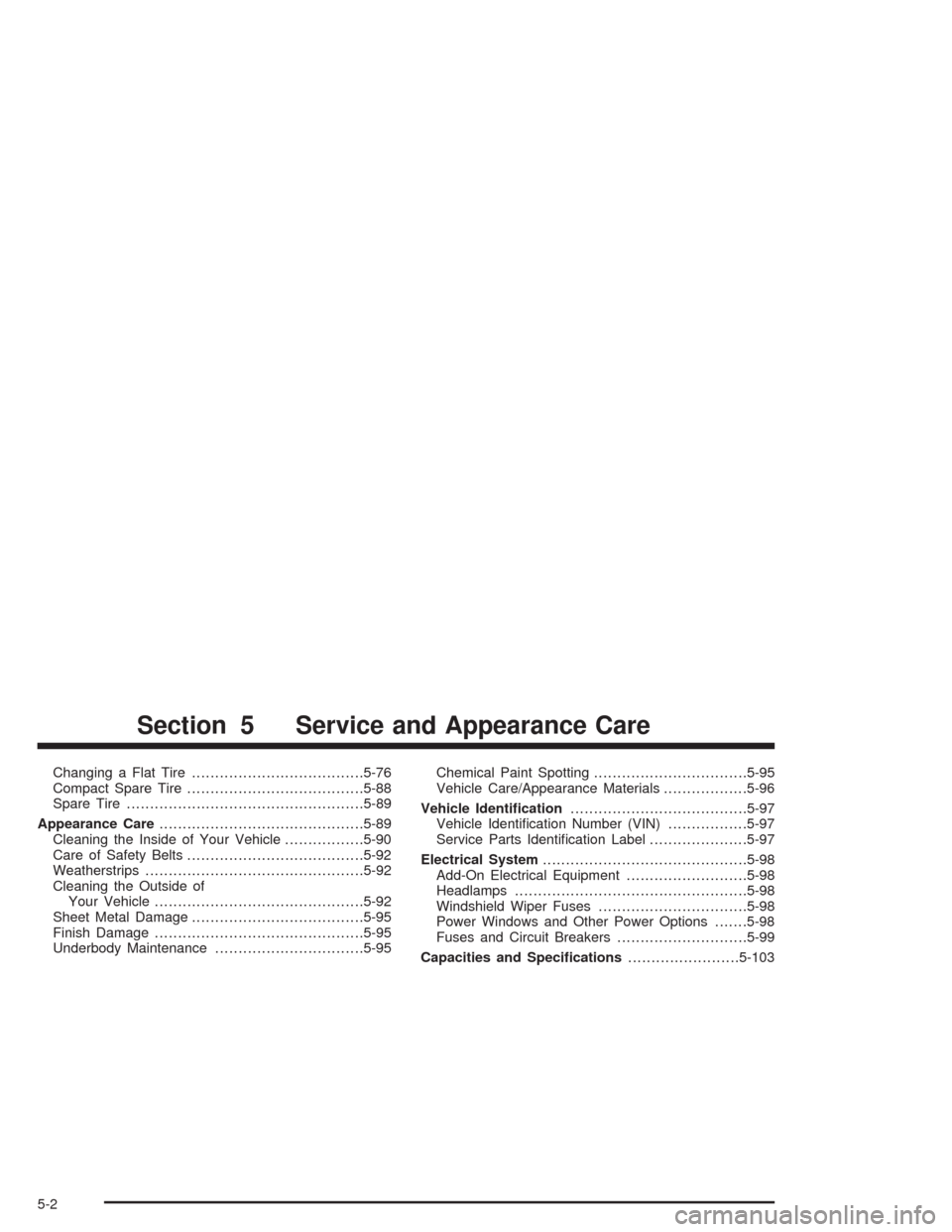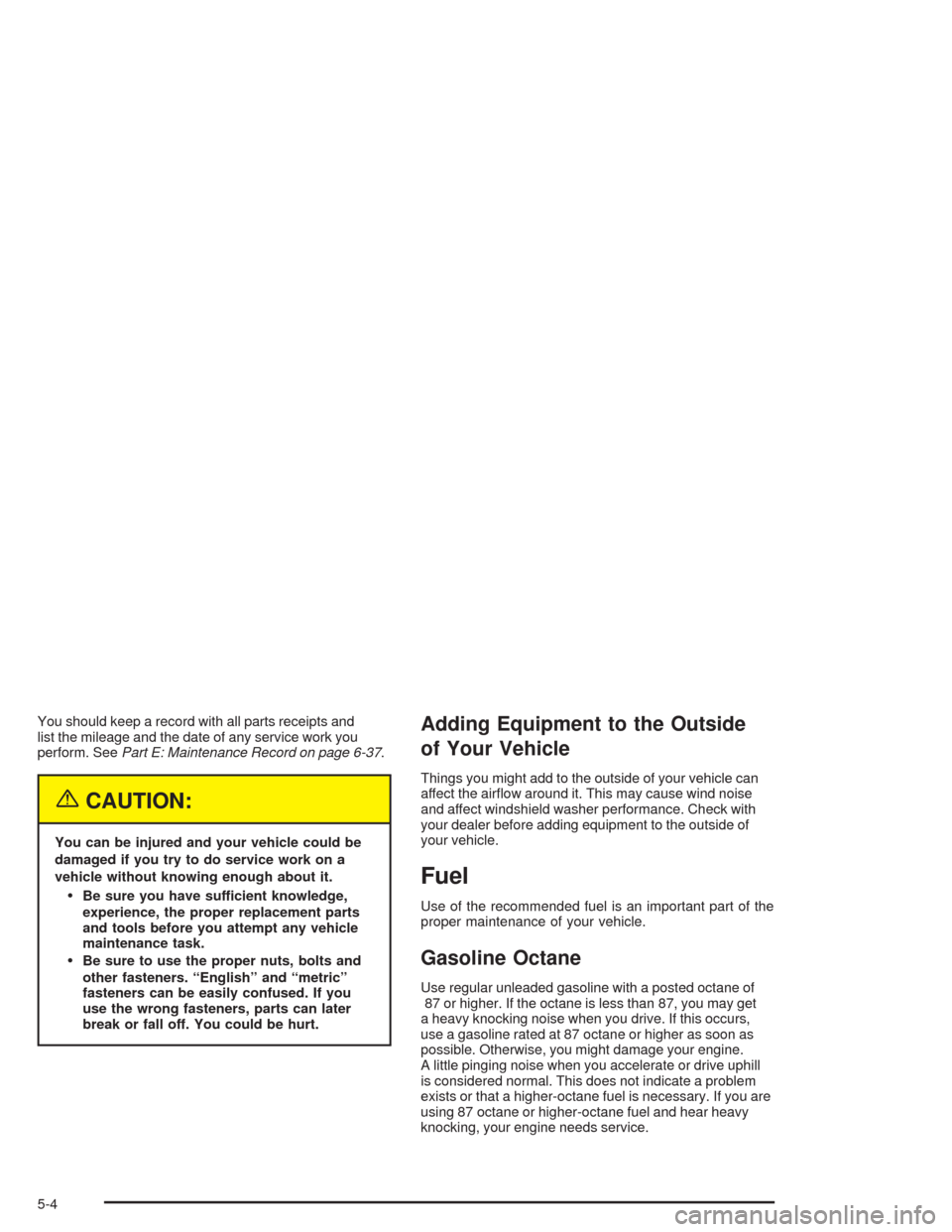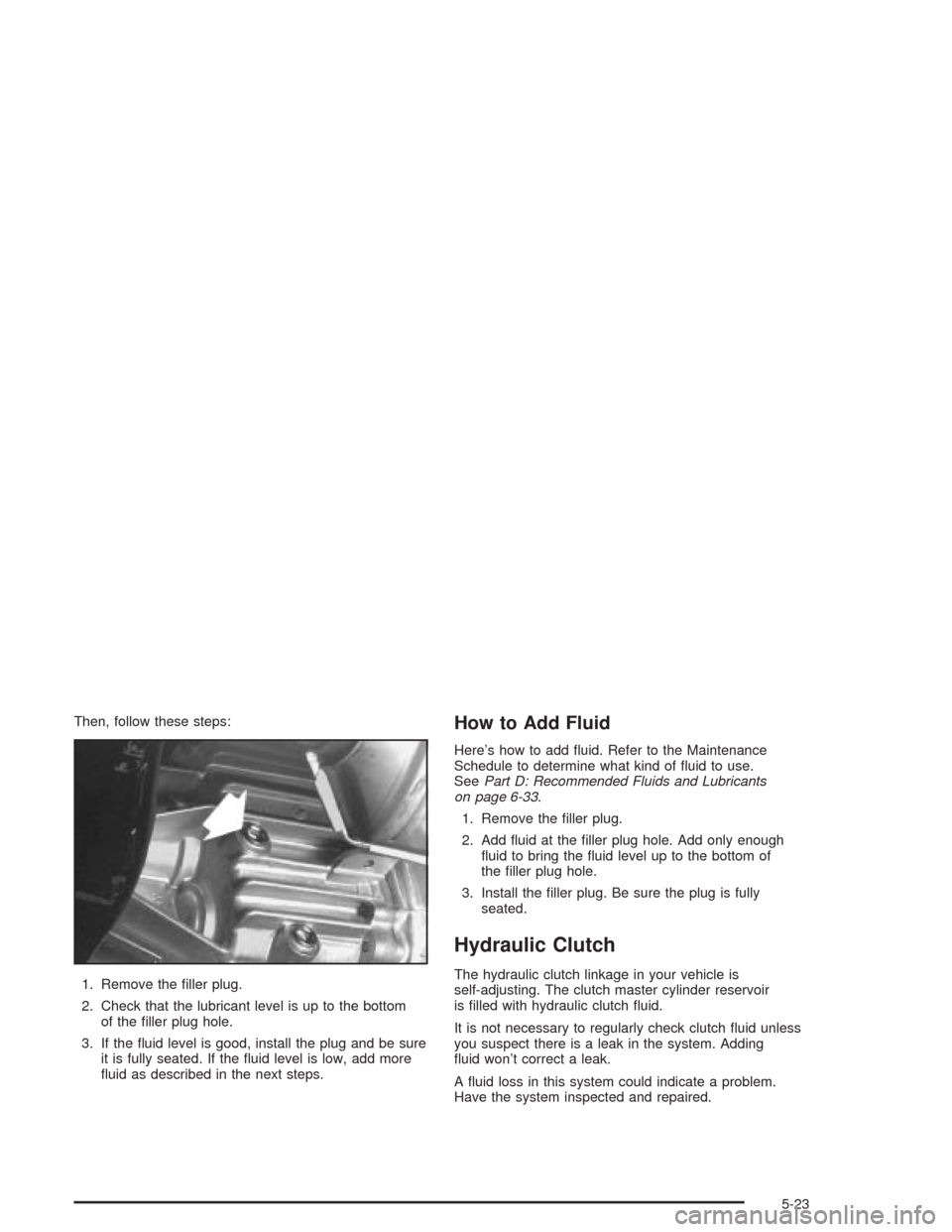2004 CHEVROLET BLAZER maintenance
[x] Cancel search: maintenancePage 275 of 446

Maintenance When Trailer Towing
Your vehicle will need service more often when you’re
pulling a trailer. See the Maintenance Schedule for more
on this. Things that are especially important in trailer
operation are automatic transmission �uid (don’t over�ll),
engine oil, axle lubricant, belt, cooling system and
brake system. Each of these is covered in this manual,
and the Index will help you �nd them quickly. If
you’re trailering, it’s a good idea to review these sections
before you start your trip.
Check periodically to see that all hitch nuts and bolts
are tight.
Trailer Wiring Harness
The light-duty trailer wiring is a six-wire harness
assembly. The optional heavy-duty trailer wiring is an
eight-wire harness assembly. The harnesses are stored
under the vehicle, along the passenger-side frame
crossmember on two-door vehicles or on the driver’s
side corner frame rear crossmember on four-door
vehicles. The heavy-duty trailer wiring is fused in the
engine compartment fuse block. SeeFuses and Circuit
Breakers on page 5-99. Both harnesses have no
connector and should be wired by a quali�ed electrical
technician.The technician can use the following color code chart
when connecting the wiring harness to your trailer.
Dark Blue: Use for electric trailer brakes or auxiliary
wiring (eight-wire harness only).
Red: Use for battery charging; it connects to the
starter solenoid (eight-wire harness only).
Light Green: Back-up lamps.
Brown: Taillamps and parking lamps.
Yellow: Driver’s side stoplamp and turn signal.
Dark Green: Passenger’s side stoplamp and turn
signal.
White: Ground wire.
Light Blue: Auxiliary stoplamp.
Securely attach the harness to the trailer, then tape or
strap it to your vehicle’s frame rail. Be sure you
leave it loose enough so the wiring doesn’t bend or
break, but not so loose that it drags on the ground. Store
the harness in its original place. Wrap the harness
together and tie it neatly so it won’t be damaged.
4-71
Page 278 of 446

Changing a Flat Tire.....................................5-76
Compact Spare Tire......................................5-88
Spare Tire...................................................5-89
Appearance Care............................................5-89
Cleaning the Inside of Your Vehicle.................5-90
Care of Safety Belts......................................5-92
Weatherstrips...............................................5-92
Cleaning the Outside of
Your Vehicle.............................................5-92
Sheet Metal Damage.....................................5-95
Finish Damage.............................................5-95
Underbody Maintenance................................5-95Chemical Paint Spotting.................................5-95
Vehicle Care/Appearance Materials..................5-96
Vehicle Identi�cation......................................5-97
Vehicle Identi�cation Number (VIN).................5-97
Service Parts Identi�cation Label.....................5-97
Electrical System............................................5-98
Add-On Electrical Equipment..........................5-98
Headlamps..................................................5-98
Windshield Wiper Fuses................................5-98
Power Windows and Other Power Options.......5-98
Fuses and Circuit Breakers............................5-99
Capacities and Speci�cations........................5-103
Section 5 Service and Appearance Care
5-2
Page 280 of 446

You should keep a record with all parts receipts and
list the mileage and the date of any service work you
perform. SeePart E: Maintenance Record on page 6-37.
{CAUTION:
You can be injured and your vehicle could be
damaged if you try to do service work on a
vehicle without knowing enough about it.
Be sure you have sufficient knowledge,
experience, the proper replacement parts
and tools before you attempt any vehicle
maintenance task.
Be sure to use the proper nuts, bolts and
other fasteners. “English” and “metric”
fasteners can be easily confused. If you
use the wrong fasteners, parts can later
break or fall off. You could be hurt.
Adding Equipment to the Outside
of Your Vehicle
Things you might add to the outside of your vehicle can
affect the air�ow around it. This may cause wind noise
and affect windshield washer performance. Check with
your dealer before adding equipment to the outside of
your vehicle.
Fuel
Use of the recommended fuel is an important part of the
proper maintenance of your vehicle.
Gasoline Octane
Use regular unleaded gasoline with a posted octane of
87 or higher. If the octane is less than 87, you may get
a heavy knocking noise when you drive. If this occurs,
use a gasoline rated at 87 octane or higher as soon as
possible. Otherwise, you might damage your engine.
A little pinging noise when you accelerate or drive uphill
is considered normal. This does not indicate a problem
exists or that a higher-octane fuel is necessary. If you are
using 87 octane or higher-octane fuel and hear heavy
knocking, your engine needs service.
5-4
Page 292 of 446

Notice:Use only engine oil identi�ed as meeting
GM Standard GM6094M and showing the American
Petroleum Institute Certi�ed For Gasoline Engines
starburst symbol. Failure to use the recommended
oil can result in engine damage not covered by your
warranty.
GM Goodwrench
®oil meets all the requirements for
your vehicle.
If you are in an area of extreme cold, where the
temperature falls below−20°F (−29°C), it is
recommended that you use either an SAE 5W-30
synthetic oil or an SAE 0W-30 oil. Both will provide
easier cold starting and better protection for your
engine at extremely low temperatures.
Engine Oil Additives
Do not add anything to your oil. The recommended
oils with the starburst symbol that meet GM Standard
GM6094M are all you will need for good performance
and engine protection.
When to Change Engine Oil
If any one of these is true for you, use the short trip/city
maintenance schedule:
Most trips are less than 5 miles (8 km). This is
particularly important when outside temperatures
are below freezing.
Most trips include extensive idling (such as frequent
driving in stop-and-go traffic).
You frequently tow a trailer or use a carrier on top
of your vehicle.
The vehicle is used for delivery service, police, taxi
or other commercial application.
Driving under these conditions causes engine oil to
break down sooner. If any one of these is true for your
vehicle, then you need to change your oil and �lter
every 3,000 miles (5 000 km) or 3 months — whichever
occurs �rst.
If none of them is true, use the long trip/highway
maintenance schedule. Change the oil and �lter every
7,500 miles (12 500 km) or 12 months — whichever
occurs �rst. Driving a vehicle with a fully warmed engine
under highway conditions will cause engine oil to
break down slower.
5-16
Page 294 of 446

When to Inspect the Engine
Air Cleaner/Filter
Inspect the air cleaner/�lter every 15,000 miles
(25 000 km) and replace every 30,000 miles (50 000 km).
If you are driving in dusty/dirty conditions, inspect the
�lter at each engine oil change.
How to Inspect the Engine
Air Cleaner/Filter
To inspect the air cleaner/�lter remove the �lter from
the vehicle and lightly shake �lter to release loose dust
and dirt. If the �lter remains “caked” with dirt, a new
�lter is required.
To inspect or replace the �lter do the following:
1. Remove the fasteners that hold the cover on
and remove the cover.
2. Lift out the engine air cleaner/�lter.
3. Insert a new air �lter, if needed. SeeNormal
Maintenance Replacement Parts on page 6-35
to determine which �lter to use.
4. Reinstall the engine air cleaner/�lter cover.
5-18
Page 295 of 446

{CAUTION:
Operating the engine with the air cleaner/�lter
off can cause you or others to be burned.
The air cleaner not only cleans the air, it helps
to stop �ame if the engine back�res. If it is
not there and the engine back�res, you could
be burned. Do not drive with it off, and be
careful working on the engine with the air
cleaner/�lter off.
Notice:If the air cleaner/�lter is off, a back�re
can cause a damaging engine �re. And, dirt
can easily get into your engine, which will damage
it. Always have the air cleaner/�lter in place
when you are driving.
Automatic Transmission Fluid
When to Check and Change
A good time to check your automatic transmission
�uid level is when the engine oil is changed.
Change both the �uid and �lter every 15,000 miles
(25 000 km) if the vehicle is mainly driven under one
or more of these conditions:
In heavy city traffic where the outside temperature
regularly reaches 90°F (32°C) or higher.
In hilly or mountainous terrain.
When doing frequent trailer towing.
Uses such as found in taxi, police or delivery
service.
If you do not use your vehicle under any of these
conditions, change the �uid and �lter every
50,000 miles (83 000 km).
SeePart A: Scheduled Maintenance Services on
page 6-4.
5-19
Page 298 of 446

How to Add Fluid
Refer to the Maintenance Schedule to determine
what kind of transmission �uid to use. SeePart D:
Recommended Fluids and Lubricants on page 6-33.
Add �uid only after checking the transmission �uid while
it is hot. (A cold check is used only as a reference.)
If the �uid level is low, add only enough of the proper
�uid to bring the level up to the HOT area for a hot
check. It doesn’t take much �uid, generally less than
one pint (0.5 L).Don’t over�ll.
Notice:We recommend you use only �uid labeled
DEXRON
®-III, because �uid with that label is
made especially for your automatic transmission.
Damage caused by �uid other than DEXRON
®-III is
not covered by your new vehicle warranty.
After adding �uid, recheck the �uid level as
described under “How to Check”.
When the correct �uid level is obtained, push the
dipstick back in all the way; then �ip the handle
down to lock the dipstick in place.
Manual Transmission Fluid
When to Check
A good time to have it checked is when the engine oil is
changed. However, the �uid in your manual transmission
doesn’t require changing.
How to Check
Becausethis operation can be a little difficult, you may
choose to have this done at your GM dealership service
department.
If you do it yourself, be sure to follow all the instructions
here, or you could get a false reading.
Notice:Too much or too little �uid can damage
your transmission. Too much can mean that some
of the �uid could come out and fall on hot engine
part or exhaust system parts, starting a �re.
Too little �uid could cause the transmission to
overheat. Be sure to get an accurate reading if
you check your transmission �uid.
Check the �uid level only when your engine is off, the
vehicle is parked on a level place and the transmission
is cool enough for you to rest your �ngers on the
transmission case.
5-22
Page 299 of 446

Then, follow these steps:
1. Remove the �ller plug.
2. Check that the lubricant level is up to the bottom
of the �ller plug hole.
3. If the �uid level is good, install the plug and be sure
it is fully seated. If the �uid level is low, add more
�uid as described in the next steps.How to Add Fluid
Here’s how to add �uid. Refer to the Maintenance
Schedule to determine what kind of �uid to use.
SeePart D: Recommended Fluids and Lubricants
on page 6-33.
1. Remove the �ller plug.
2. Add �uid at the �ller plug hole. Add only enough
�uid to bring the �uid level up to the bottom of
the �ller plug hole.
3. Install the �ller plug. Be sure the plug is fully
seated.
Hydraulic Clutch
The hydraulic clutch linkage in your vehicle is
self-adjusting. The clutch master cylinder reservoir
is �lled with hydraulic clutch �uid.
It is not necessary to regularly check clutch �uid unless
you suspect there is a leak in the system. Adding
�uid won’t correct a leak.
A �uid loss in this system could indicate a problem.
Have the system inspected and repaired.
5-23